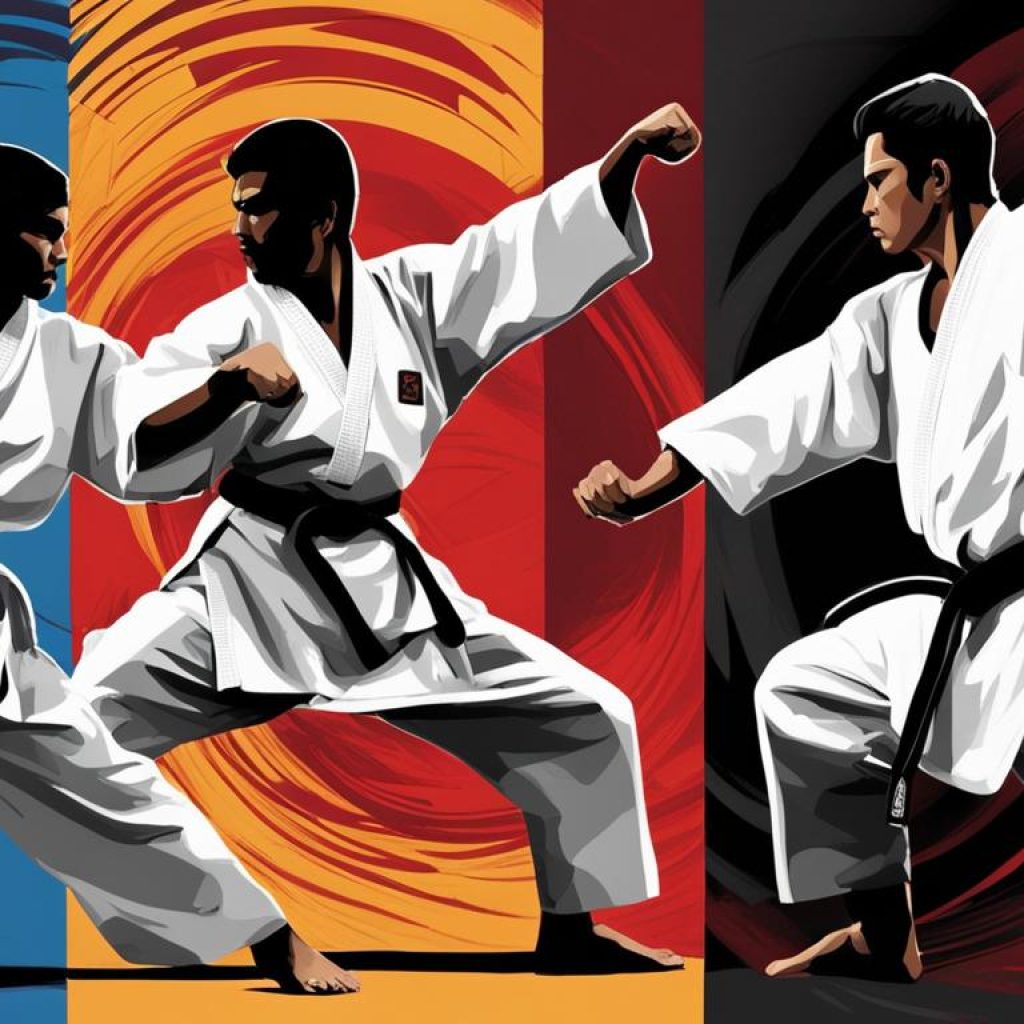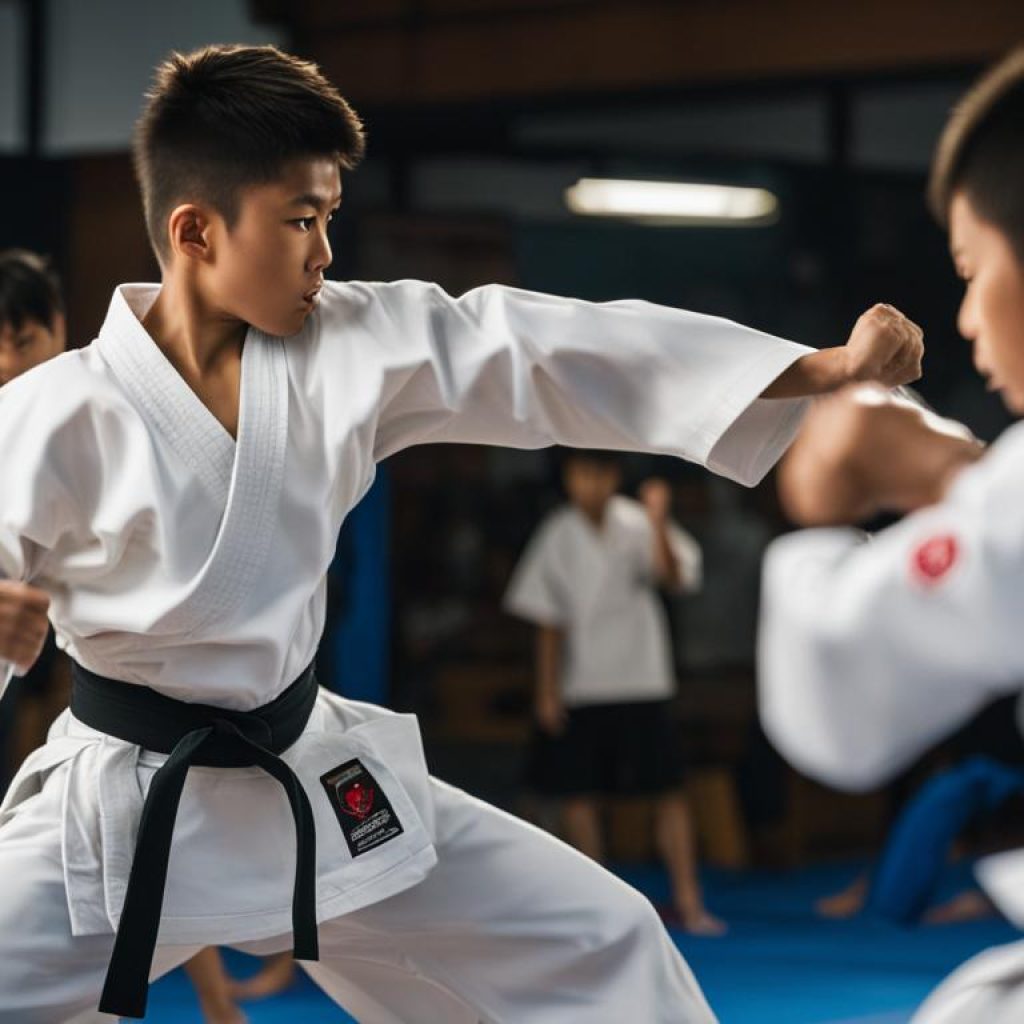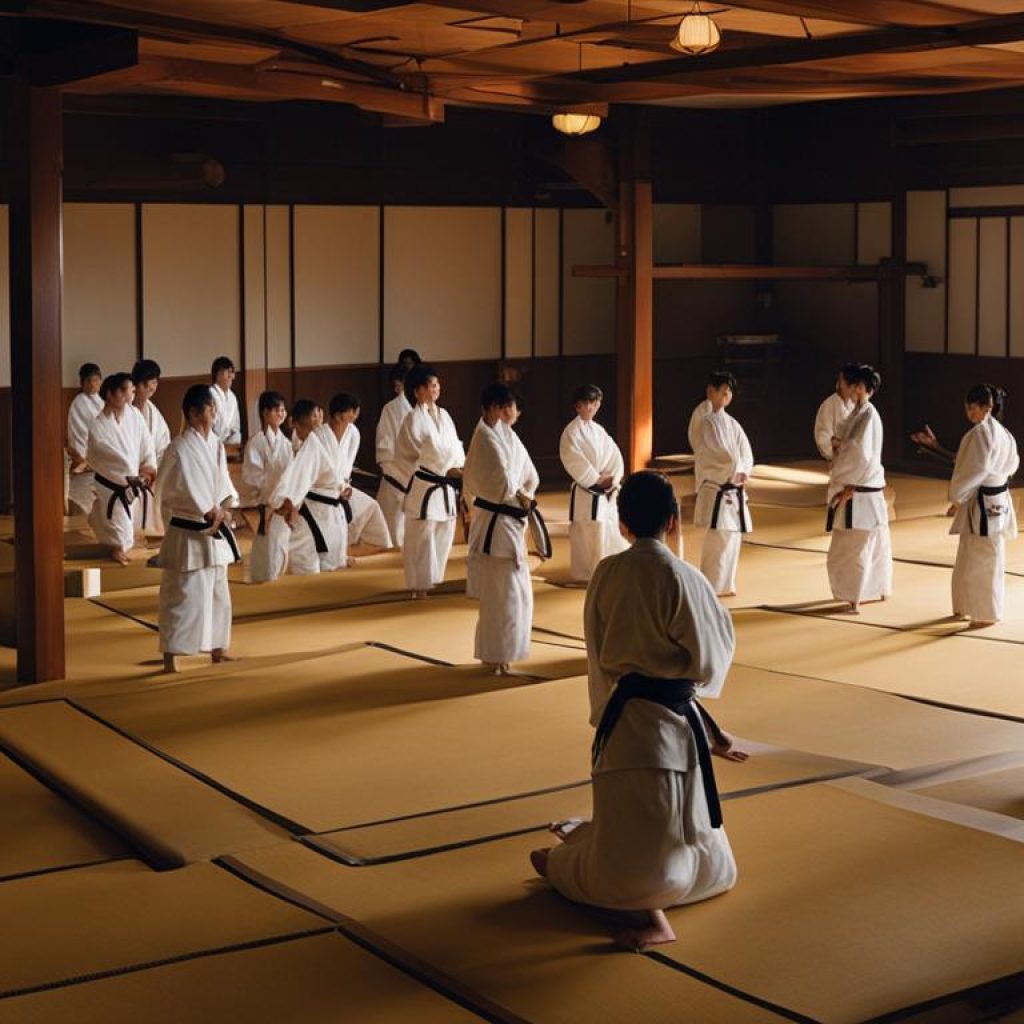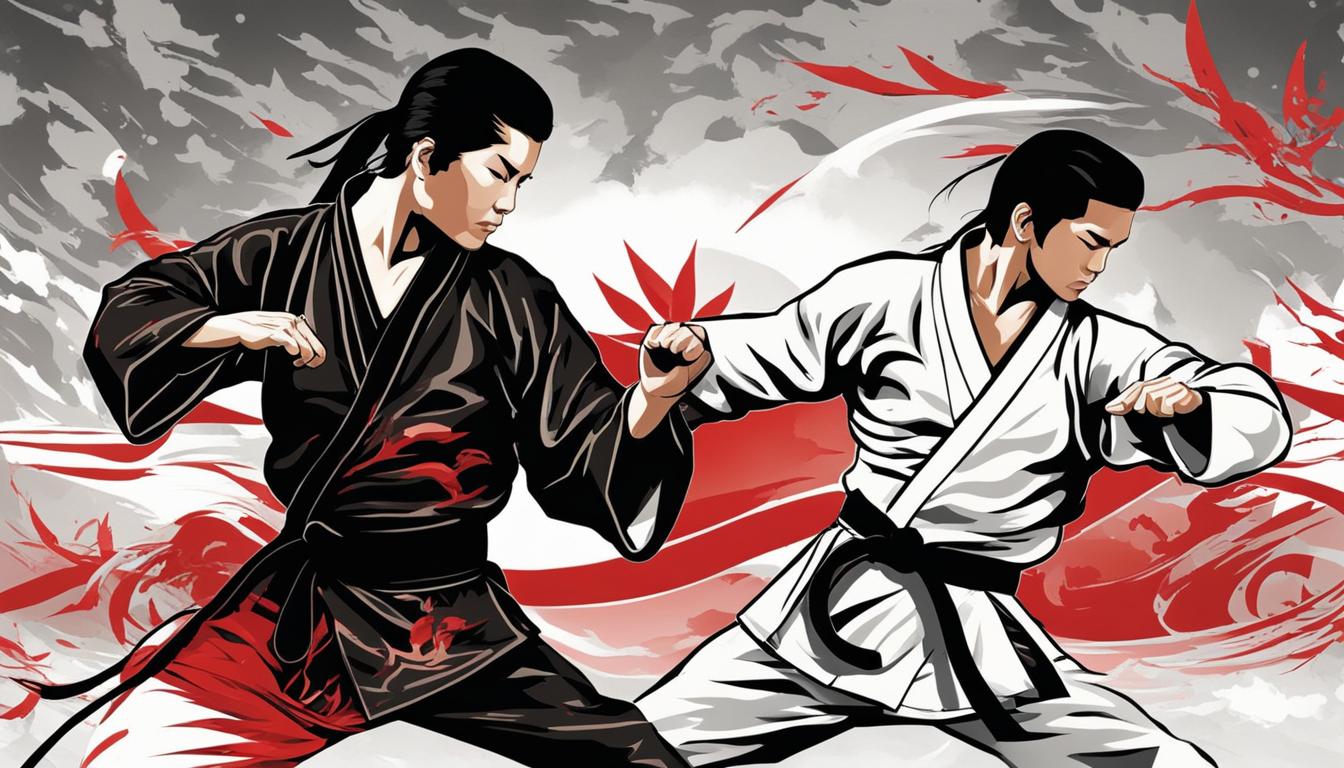Karate, also known as Karate-do, is a martial art that originated in the Ryukyu Kingdom, which is present-day Okinawa Prefecture, Japan. It developed from the indigenous martial arts of the Ryukyu Islands, under the influence of Chinese martial arts. Karate is primarily a striking art that uses punches, kicks, knee strikes, elbow strikes, and open-hand techniques. It also incorporates grappling, throws, joint locks, restraints, and vital-point strikes. Karate has a rich history and is practiced worldwide, with various styles such as Shotokan, Goju-ryu, Wado-ryu, and Shito-ryu.
Key Takeaways:
- Karate is a martial art that originated in the Ryukyu Kingdom, Japan.
- It developed from the indigenous martial arts of the Ryukyu Islands, influenced by Chinese martial arts.
- Karate is primarily a striking art that incorporates various techniques and styles.
- Some of the well-known karate styles include Shotokan, Goju-ryu, Wado-ryu, and Shito-ryu.
- Karate offers numerous physical and mental benefits, promoting discipline, fitness, self-confidence, and self-defense skills.
The Origins of Karate
Karate has a fascinating origin story that traces back to the Ryukyu Kingdom, located in present-day Okinawa Prefecture, Japan. The martial art developed from the indigenous martial arts of the Ryukyu Islands, known as te or tii in Okinawan. These ancient fighting techniques were heavily influenced by Chinese martial arts, particularly the Fujian White Crane style.
The development of Karate was further propelled by the political centralization of Okinawa and the ban on weapons imposed during the 15th and 17th centuries. As a result, the Ryukyu people focused on the refining their unarmed combat techniques, leading to the emergence of Karate as a formidable martial art.
Chinese settlers in Okinawa also played a crucial role in shaping Karate. They brought with them their own martial arts techniques, which were then blended with the indigenous styles, creating a unique fusion of Chinese and Okinawan self-defense techniques.
These influences from both indigenous martial arts and Chinese martial arts laid the foundation for what we now know as Karate. This blend of styles encompasses a wide range of striking techniques, kicks, knee strikes, elbow strikes, and open-hand techniques.
“Karate originated in the Ryukyu Islands, influenced by the indigenous martial arts and Chinese martial arts. It is the result of a remarkable fusion of these diverse cultures and their combat traditions.”
The integration of Chinese and Okinawan martial arts in Karate reflects the rich cultural exchange and the collaborative efforts of different societies. This fusion has resulted in a unique martial art form that emphasizes both physical prowess and mental discipline.
With its origins firmly rooted in the Ryukyu Kingdom and its development influenced by indigenous martial arts and Chinese traditions, Karate has evolved into a global martial art practiced by millions today.
Types of Karate
Karate encompasses various styles, each with unique characteristics and techniques. Understanding the different karate styles can provide insights into their specific approaches and philosophies.
Shotokan
Shotokan is one of the most popular karate styles worldwide. It emphasizes powerful, linear strikes and deep stances. Practitioners focus on developing strong fundamental techniques through rigorous training. Shotokan practitioners also engage in kata, which are prearranged forms or sequences of movements that develop form, balance, and focus.
Goju-ryu
Goju-ryu, meaning “hard-soft style,” blends hard striking techniques with circular and fluid movements. This style emphasizes combining strength with flexibility, utilizing breathing exercises to improve overall power. The practice of hojo undo, which involves training with specific karate tools and equipment, is often incorporated to develop body conditioning and strength.
Wado-ryu
Wado-ryu places a strong emphasis on evasion and redirecting an opponent’s strike to create opportunities for effective counterattacks. Its techniques utilize economy of motion, employing efficient and precise movements. Wado practitioners also focus on taisabaki, the art of body shifting and positioning, to maintain balance and advantage in combat situations.
Shito-ryu
Shito-ryu combines both hard and soft techniques, incorporating dynamic footwork and fluid movements. Speed and agility are key components of Shito-ryu, as practitioners strive for effortless transitions between techniques. This style emphasizes the importance of timing and precision in executing strikes and blocks.
Other notable karate styles include Uechi-ryu, Ashihara, Chito-ryu, Enshin, Kishimoto-di, and Kyokushin, each offering unique approaches to techniques, training methods, and philosophies.

| Karate Style | Characteristic | Techniques |
|---|---|---|
| Shotokan | Linear and forceful strikes | Punches, kicks, kata |
| Goju-ryu | Hard and soft techniques, circular movements | Strikes, grappling, hojo undo |
| Wado-ryu | Evading strikes, countering with punches and kicks | Taisabaki, strikes, kata |
| Shito-ryu | Fluidity and speed | Strikes, blocks, kata |
| Uechi-ryu | Combines Chinese and Okinawan martial arts | Strikes, grappling, conditioning |
| Ashihara | Efficient and direct techniques | Punches, kicks, throws |
| Chito-ryu | Focuses on practical self-defense | Blocks, strikes, grappling |
| Enshin | Utilizes Sabaki method for close-quarters fighting | Throws, strikes, groundwork |
| Kishimoto-di | Blends karate and kung fu techniques | Strikes, joint locks, throws |
| Kyokushin | Emphasizes full-contact sparring and physical conditioning | Punches, kicks, knee strikes |
Benefits of Karate
Karate offers numerous benefits that encompass both the physical and mental aspects of one’s well-being. Whether you are seeking to enhance your physical fitness, develop discipline and focus, or learn self-defense techniques, karate provides a holistic practice that nurtures the mind, body, and spirit.
One of the key advantages of practicing karate is the promotion of physical discipline. Through regular training, practitioners improve their physical fitness, strength, flexibility, and coordination. The rigorous and structured nature of karate training helps individuals develop a strong sense of discipline, as they set goals, follow specific techniques, and maintain a consistent practice routine.
In addition to physical discipline, karate instills mental discipline as well. The practice requires focus, concentration, and perseverance. By training the mind to stay present and focused, practitioners cultivate mental clarity and discipline that can be applied to other areas of life. The ability to remain calm and centered in the face of challenges becomes a valuable life skill.
Self-defense is another important aspect of karate. While it is essential to emphasize that karate should only be used in self-defense situations, learning self-defense techniques provides individuals with the confidence and skills to protect themselves if necessary. The practical applications of karate techniques can empower individuals to navigate potentially dangerous situations with greater awareness and control.
“Karate instills physical discipline, mental discipline, and self-defense skills, while promoting overall well-being.”
Overall, karate offers a wide range of benefits that extend beyond physical fitness and self-defense. It is a practice that nurtures discipline, focus, confidence, and self-esteem. By engaging in karate, individuals develop a comprehensive understanding of their mind and body, fostering personal growth and empowerment in all aspects of life.
| Benefits of Karate |
|---|
| Physical discipline |
| Mental discipline |
| Self-defense skills |
Karate Training and Techniques
Karate training encompasses a wide range of techniques and exercises that help practitioners develop their skills and proficiency. From strikes to katas, each component contributes to the overall growth and mastery of the martial art.
Strikes
One of the fundamental aspects of karate training is learning various strikes. Practitioners acquire the ability to execute powerful punches and kicks, as well as knee strikes and elbow strikes. These techniques are honed through repeated practice and focus on precision and effectiveness.
“A punch should be like the snap of a whip.” – Miyamoto Musashi
Open-Hand Techniques
In addition to strikes, karate training includes the mastery of open-hand techniques. Knife-hands and spear-hands are among the open-hand techniques that practitioners learn. These techniques incorporate targeted strikes using the palm, fingers, and edges of the hand.
Katas
Katas are choreographed movements practiced individually or in groups. They serve as a way to enhance form, balance, and speed. By following a predefined sequence, practitioners develop muscle memory and refine their techniques. Katas also emphasize the importance of focus and mental discipline in executing precise movements.

Sparring
Sparring is an integral part of karate training, allowing practitioners to apply their techniques and strategies in a controlled environment. It provides an opportunity to practice offensive and defensive maneuvers against a live opponent. Sparring sessions help practitioners develop agility, timing, and adaptability, essential qualities in real-life combat situations.
“Sparring is not about being the best; it’s about becoming the best version of yourself.”
Karate Schools and Classes
If you’re interested in learning karate, you’ll find a wide range of karate schools, also known as dojos, around the world. These schools offer classes suitable for students of all ages and skill levels, providing an inclusive environment for anyone looking to train in this martial art.
Karate classes are typically structured and led by experienced instructors, often referred to as senseis. These instructors have a deep understanding of karate techniques and principles, ensuring that students receive quality training and guidance. Whether you’re a beginner or an advanced practitioner, karate classes can help you improve your skills and knowledge.
One notable aspect of karate training is the progression through belt ranks. As you develop your abilities and understanding of karate, you can advance to higher belt ranks, signifying your growth and expertise. The belt system allows for a clear path of advancement and motivates students to continually improve.
Moreover, karate classes provide a supportive and disciplined environment for learning and practice. Instructors and fellow students offer encouragement and guidance as you progress through the training. The discipline instilled in karate classes extends beyond the physical techniques, teaching students valuable life skills such as focus, perseverance, and respect.
So if you’re ready to embark on your karate journey, find a reputable karate school near you and start attending classes. The structured training, experienced instructors, and supportive environment will help you develop your skills and achieve your goals in karate.
Benefits of Karate Schools and Classes:
- Access to experienced instructors and knowledgeable senseis
- Inclusive classes for students of all ages and skill levels
- Structured training programs and clear progression through belt ranks
- A supportive and disciplined learning environment
- Opportunities to develop physical fitness, mental discipline, and self-confidence
Student Testimonial:
“Attending karate classes at a reputable dojo has been a life-changing experience for me. The instructors are passionate, knowledgeable, and dedicated to helping students succeed. I’ve gained strength, discipline, and confidence through my karate journey, and I couldn’t have asked for a better learning environment.”
| Benefits of Karate Schools | Benefits of Karate Classes |
|---|---|
| Access to experienced instructors | Structured training programs |
| Inclusive classes for all ages | Clear progression through belt ranks |
| Supportive learning environment | Opportunities for physical and mental development |
Karate in Popular Culture
Karate has left an indelible mark on popular culture, captivating audiences worldwide through its portrayal in movies and media. In particular, the martial arts movies of the 1960s and 1970s, notably those starring the legendary Bruce Lee, played a pivotal role in popularizing not only karate but also other martial arts forms.

These influential films showcased the awe-inspiring power and precision of karate techniques, mesmerizing viewers with dynamic fight sequences and awe-inspiring stunts. They not only entertained but also captivated audiences, sparking a growing interest in karate as a unique form of physical fitness and self-defense.
Through its prominent presence in movies and media, karate has become widely recognized and appreciated by individuals of all ages and backgrounds. It has seeped into the fabric of popular culture, earning a place in the collective consciousness and infiltrating various forms of entertainment, including literature, music, and even video games.
“Karate is not about violence; it’s about discipline and inner strength. It’s a metaphor for the struggles we face and the determination to overcome them.”
References to karate and its techniques have become commonplace in popular culture, providing a source of inspiration and fascination for enthusiasts and casual observers alike. From the iconic “wax on, wax off” training scenes in “The Karate Kid” to the deliberate grace of the Cobra Kai series, karate continues to leave an indelible mark on both cinematic and television landscapes.
The enduring popularity of karate in popular culture serves as a testament to its universal appeal and enduring legacy. As the martial art continues to captivate audiences through its portrayal in movies and media, it will undoubtedly inspire generations to embrace its physical and philosophical teachings.
The Future of Karate
Karate has gained international recognition and acceptance as a sport. In 2021, it made its debut as an Olympic sport, showcasing its global appeal. The inclusion of karate in the Olympics has not only elevated its status but also sparked greater interest and participation worldwide. As a result, the future of karate looks promising, with increased opportunities for practitioners, competitions, and overall growth in the sport.
The Olympic Games provide a platform for sports to reach a broader audience and gain widespread attention. With karate’s inclusion in the Olympics, it has captured the interest of millions of viewers worldwide, exposing them to the beauty and skill of this ancient martial art. This exposure presents an incredible opportunity for karate to attract new participants and expand its reach beyond traditional karate communities.
Moreover, the recognition of karate as an Olympic sport has prompted many countries to invest further in developing their national karate programs. Athletes now have more support and resources for training, nurturing talent, and competing at an elite level. This increased investment and focus on karate will undoubtedly contribute to the advancement and evolution of the sport.
The future of karate also holds exciting prospects for practitioners of all levels. Whether one’s goal is personal development, self-defense, or competitive success, the sport offers something for everyone. The expansion of karate’s popularity through the Olympics will likely lead to a greater number of karate schools, providing accessible and quality training opportunities to individuals worldwide.
Furthermore, the global embrace of karate as an Olympic sport fosters a spirit of unity and cultural exchange. As athletes from different countries come together to compete, they not only showcase their skills but also promote mutual respect, understanding, and friendship on a global scale. This shared passion for karate can transcend borders, creating connections and friendships that extend beyond the realm of competition.
The future of karate is bright and filled with possibilities. The sport’s inclusion in the Olympics has propelled it into the mainstream, raising its profile and attracting new practitioners. With continued support, investment, and participation, karate has the potential to flourish and become even more accessible to individuals of all ages, backgrounds, and abilities.

| Benefits of Karate’s Olympic Inclusion | Opportunities for Growth |
|---|---|
| Increased exposure to a global audience | Expansion of karate schools and training programs worldwide |
| Enhanced support and resources for athletes | Development of national karate programs |
| Promotion of mutual respect and cultural exchange | Broader access to karate for individuals of all abilities |
Conclusion
Karate, with its rich history and diverse range of styles, offers a multitude of physical and mental benefits. By practicing this martial art, you can develop discipline, enhance your fitness levels, boost self-confidence, and acquire valuable self-defense skills. Whether you choose to train at a local karate school or dojo, you’ll find a supportive environment to help you on your journey.
In recent years, karate has gained significant popularity through its portrayal in movies and media, captivating audiences worldwide. This exposure has contributed to the recognition and acceptance of karate as a respected martial art. Additionally, the inclusion of karate in the Olympics has further solidified its status as a globally recognized sport.
The future of karate looks promising, with continuing growth and advancement within the martial arts community. As more individuals engage in this timeless practice, the art form will evolve and flourish. So, whether you seek physical fitness, mental discipline, or a means of self-expression, karate can provide a fulfilling and rewarding journey.
FAQ
What is karate?
Karate, also known as Karate-do, is a martial art that originated in the Ryukyu Kingdom, which is present-day Okinawa Prefecture, Japan. It developed from the indigenous martial arts of the Ryukyu Islands, under the influence of Chinese martial arts.
What are some styles of karate?
Karate has various styles, including Shotokan, Goju-ryu, Wado-ryu, and Shito-ryu. Other styles include Uechi-ryu, Ashihara, Chito-ryu, Enshin, Kishimoto-di, and Kyokushin.
What are the benefits of practicing karate?
Karate promotes physical fitness, strength, flexibility, coordination, discipline, focus, perseverance, self-confidence, self-esteem, and self-defense skills. It is a holistic practice that develops the mind, body, and spirit.
What techniques are involved in karate training?
Karate training includes strikes such as punches, kicks, knee strikes, and elbow strikes. It also incorporates open-hand techniques like knife-hands and spear-hands. Practitioners practice katas, which are choreographed movements, and engage in sparring to practice techniques in a controlled environment.
Where can I find karate schools or classes?
Karate schools, also known as dojos, can be found worldwide. They offer classes for students of all ages and skill levels. These classes are typically structured and led by experienced instructors or senseis.
How has karate influenced popular culture?
Karate gained popularity through its portrayal in movies and media, particularly in martial arts movies from the 1960s and 1970s. This increased the interest in karate as a form of physical fitness and self-defense.
Is karate recognized as an Olympic sport?
Yes, karate was debuted as an Olympic sport in 2021, showcasing its global appeal. Its inclusion in the Olympics has further propelled its popularity and may lead to increased participation and exposure worldwide.
What does the future hold for karate?
The future of karate looks promising, with ongoing growth and development in the martial arts community. It has gained international recognition and acceptance as a sport, and the Olympics has solidified its place as a globally recognized martial art.
Source Links
- https://www.healthline.com/health/exercise-fitness/types-of-karate
- https://en.wikipedia.org/wiki/Karate
- https://buffalotkd.com/types-of-martial-arts/
martial arts styles: karate – origin
Last modified: December 18, 2023




